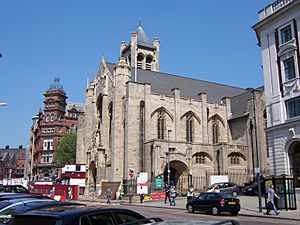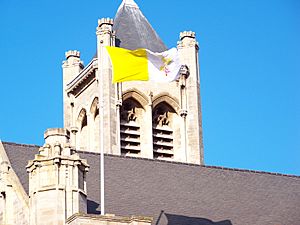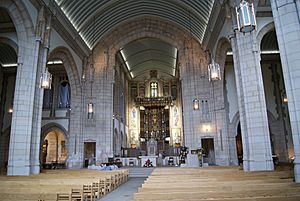Leeds Cathedral facts for kids
Quick facts for kids Leeds Cathedral |
|
|---|---|
| Cathedral Church of St Anne | |
 |
|
| Lua error in Module:Location_map at line 420: attempt to index field 'wikibase' (a nil value). | |
| OS grid reference | SE 29947 33908 |
| Location | Leeds, West Yorkshire |
| Country | England |
| Denomination | Catholic Church |
| Website | dioceseofleeds.org.uk/cathedral |
| History | |
| Consecrated | 1904 |
| Architecture | |
| Heritage designation | Grade II* |
| Architect(s) | John Henry Eastwood |
| Style | Neo-gothic |
| Years built | 1901-1904 |
| Specifications | |
| Number of towers | 1 |
| Administration | |
| Parish | Mother of Unfailing Help |
| Deanery | Leeds North |
| Diocese | Leeds (since 1878) |
| Province | Liverpool (since 1911) |
Leeds Cathedral, also known as the Cathedral Church of St Anne, is a very important church in Leeds, West Yorkshire, United Kingdom. It is the main church for the Roman Catholic Diocese of Leeds and where the Roman Catholic Bishop of Leeds has his official seat.
Even though Leeds is a big city, it doesn't have a Church of England cathedral. Instead, it has a Minster, which is a large parish church. The Catholic cathedral is a special building, and it was restored in 2006. It is listed as a Grade II* building, meaning it's a very important historic place.
Contents
History of Leeds Cathedral
The First Cathedral Building
The first Catholic church in Leeds after the Reformation was Lady Lane Chapel, built in 1786. This was later replaced by St Anne's Church in 1838. At that time, there were only two Catholic churches in Leeds.
In 1878, St Anne's Church became the first cathedral for the new Diocese of Leeds. However, its time as a cathedral was short. Around 1899, the city council decided to make The Headrow street wider. This meant the cathedral building had to be bought by the council and then torn down.
The land where the old cathedral stood is now home to The Light entertainment complex. Some parts of the old church were saved and used in the new cathedral. Other pieces can be seen at the Castle-by-the-Sea Hotel in Scarborough, North Yorkshire.
The Current Cathedral Building
The cathedral you see today was designed by John Henry Eastwood. He was an architect from Leeds who had designed other churches. The new building was made in the Arts and Crafts style, which is a type of Gothic Revival.
Because the building plot was small, the cathedral was designed without large side wings. Construction started in 1901, and the new cathedral opened its doors in 1904. After some renovations between 2005 and 2006, special items called relics were placed in the altar. These relics belong to English Catholic martyrs, Blessed Peter Snow and Ralph Grimston.
Design and Features
The cathedral is not very large because of the limited space it was built on. It has a main area called a nave with aisles, and a chancel, all under one continuous roof. There are also smaller side sections called transepts and chapels.
The building is made from Weldon stone with details from Ketton stone. The front of the cathedral has a tall pointed section called a gable. It also features a large, fancy crucifix sculpture. The north side of the church has some elements that look like mock-Georgian style, including bay windows with leaded glass.
There is a small tower on the north-west corner of the building. Sometimes, the Flag of Vatican City is flown from this tower. Inside, the cathedral has a traditional layout with rows of pews facing the altar. There are two lines of stone pillars along each side, and the ceiling is shaped like a barrel.
Organs of the Cathedral

The main organ in the cathedral was built in 1904 by Norman and Beard. It was later restored and made bigger in 2010 by a company called Klais Orgelbau. This organ is very impressive, with seven sections and 55 sets of pipes.
The cathedral also has a smaller, portable organ called a chamber organ. This organ was made by Peter Collins in 1992. It can be moved around and is usually found near the choir in the Sanctuary. It is used every day to play Gregorian chant, which is a type of old church music.
See also
 In Spanish: Catedral de Santa Ana (Leeds) para niños
In Spanish: Catedral de Santa Ana (Leeds) para niños
- Grade II* listed buildings in Leeds
- Listed buildings in Leeds (City and Hunslet Ward - northern area)


